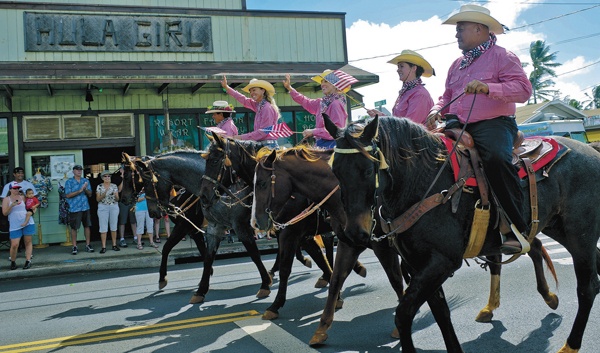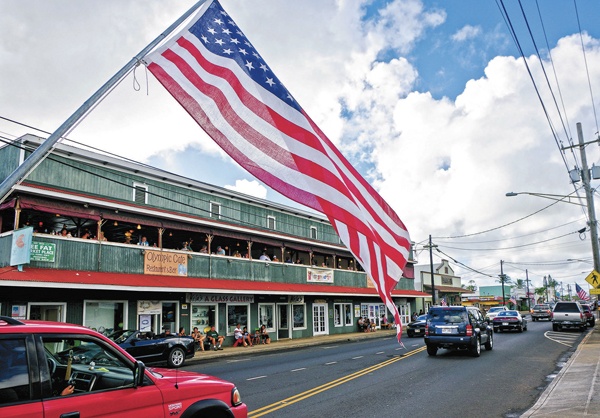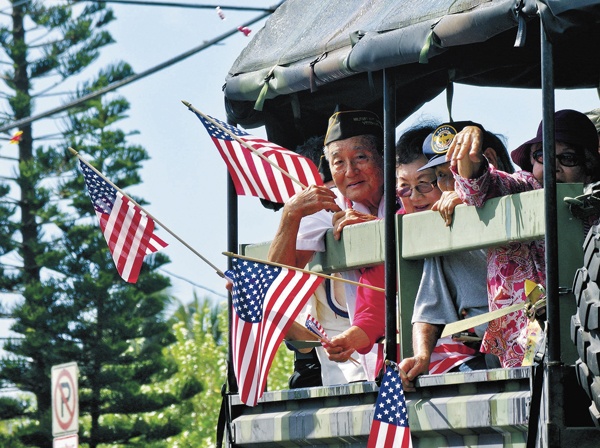KAPAA — Neither the light rain in the morning nor the glaring sun at noon drove a soul away from the Veterans Day Parade and celebration in Kapaa Saturday. “It feels good to see so many supporters for the veterans,”
KAPAA — Neither the light rain in the morning nor the glaring sun at noon drove a soul away from the Veterans Day Parade and celebration in Kapaa Saturday.
“It feels good to see so many supporters for the veterans,” Wailua resident and Desert Storm veteran Adam Wojak said, with his young son by his side. “I feel a lot in my heart.”
However, there was a time when veterans did not get the same support and appreciation from American citizens.
“When I came back (from Vietnam) they were throwing garbage at us and calling us baby killers,” said Vietnam veteran Casey Witek, of Parkridge, Ill. To watch the parade, he said, makes him “mellow.”
“I lost a lot of friends in Vietnam,” he said.
The country is strong today because of those who served in many wars, Witek said. Without them, he said, we would be speaking Chinese, German or Japanese.
Lihue resident and Vietnam veteran Myron Dobashi said it’s great to see the appreciation for those who served in wars, as opposed to what happened when he came back from Vietnam.
Back then, he said, the military was vilified. But the United States is not a dictatorship — the military is not deployed unless the government says so, Dobashi said.
For World War II veteran Robert Filkosky, a lie nearly cost him his life but etched his name into history.
The West Virginia resident enlisted in the Marine Corps Dec. 1, 1942, when he was only 14 years old, and is the youngest man to have ever joined the Marine Corps, according to Filkosky’s daughter, Kapaa resident Marla Schaefer.
“His name is in Ripley’s Believe it or Not,” she said.
Filkosky’s father was killed in an accident in 1936. When Filkosky joined the Marine Corps, his two older brothers were already fighting the Axis powers in Europe, flying planes for the Royal Canadian Artillery and England’s Royal Air Force.
So Filkosky did what he had to do.
“I lied about my age,” said the 86-year-old veteran.
When his superiors found out they had been tricked, they frowned upon Filkosky, he said. But by then he was 30 days short of turning 17 years old and being allowed to fight, so they gave him the option to stay. He stayed, and witnessed what only a few have seen in person, and millions have seen in a picture.
On Jan. 19, 1945, Filkosky, then 17 years old, landed on Iwo Jima, and what ensued was “the bloodiest battle in the history of the Marine Corps,” he said.
On Sept. 23, 1945, he took two bullets to his head, but survived. As he laid on the beach on Iwo Jima, waiting to be evacuated to a hospital ship, he noticed a commotion far away on top of a hill. He said he picked up the binoculars to see what was going on.
“That’s when I saw it, they took the small flag down and put the large flag up,” Filkosky said.
Atop Mount Suribachi, photographer Joe Rosenthal photographed six American servicemen raising the American flag. The photograph went on to win a Pulitzer Prize that same year, and later inspired a 100-ton bronze statue at Arlington, Va.
Filkosky would leave the Marine Corps Oct. 26, 1945, as a sergeant and with two purple hearts.
His history is forever kept at the National Marine Corps Museum in Quantico, Va. Filkosky’s damaged helmet, with two bullet holes in it, is on display there.
Filkosky’s older brother, Sam, was turned down by the U.S. Air Force because he was color blind, so he joined the RCA, and flew all over Europe piloting the super-light and super-fast plywood bomber Mosquito. His other brother, Ted, was a gunner on a Lancaster bomber, arguably one the most dangerous jobs in World War II, when 8,000 of those planes were shot down.
Filkosky’s brothers also survived the war, but both would die in plane accidents years later. Ted died after he crashed a small private plane he was piloting under a storm, and Sam died in an accident while testing a jet plane.
“They died doing what they loved,” Filkosky said.
He too has had his share of post-war accidents, and said he must have guardian angel. Three years ago, while trying to get up on a rooftop, Filkosky fell off a tree, and laid on the ground for five hours before he was found. He said the doctors at the VA hospital told him it was miracle he wasn’t paralyzed — he suffered four broken vertebrae.
His spirit were just as alive as anyone’s in Kapaa Saturday as he watched the Veteran’s Day celebration, which was planned a little earlier than the actual Nov. 11 holiday.
After the parade, the public got together for a celebration at Kapaa Beach Park, with food booths and several public speakers taking central stage, including Mayor Bernard Carvalho Jr., Kauai County Councilman Mel Rapozo, pastor Scott Taylor and Parade Marshall Richard “Soup Bone” Kashiwabara.
National Guard Maj. Gen. Darryll Wong said the U.S. has close to 380,000 national guardsmen serving around the world. Hawaii National Guard alone has more firing power than most NATO nations, he said.
Desert Storm veteran Norberto Garcia brought Filkosky to the stage, and said, “We are blessed and honored with his presence.”
Korean War veteran Jimmy Oyadomari watched the post-parade celebration with the same humble attitude he carried on for nearly 60 years while working at The Garden Island newspaper, where he was hired in 1953, after his war service, until February.




